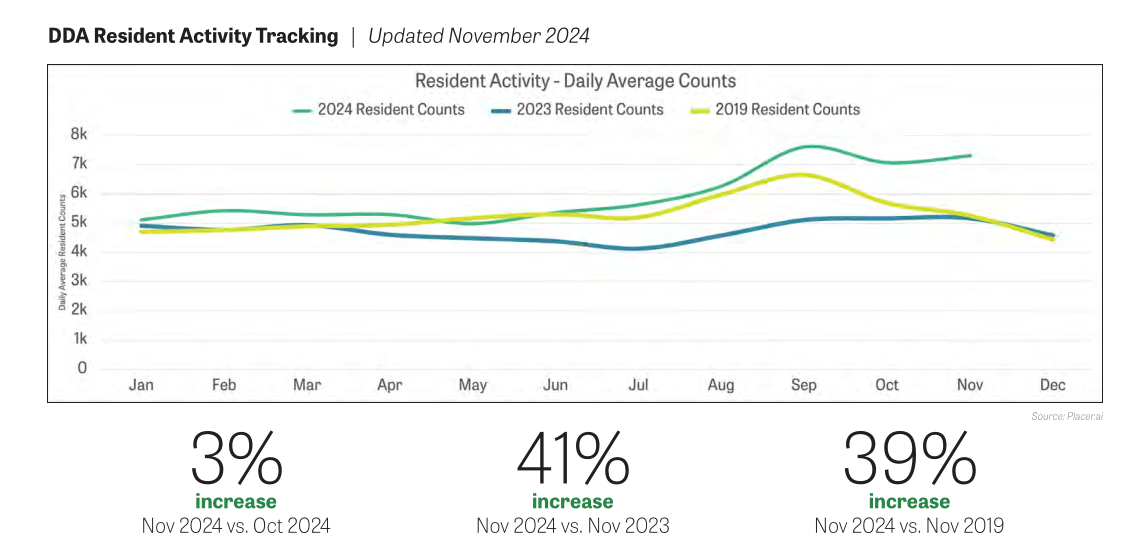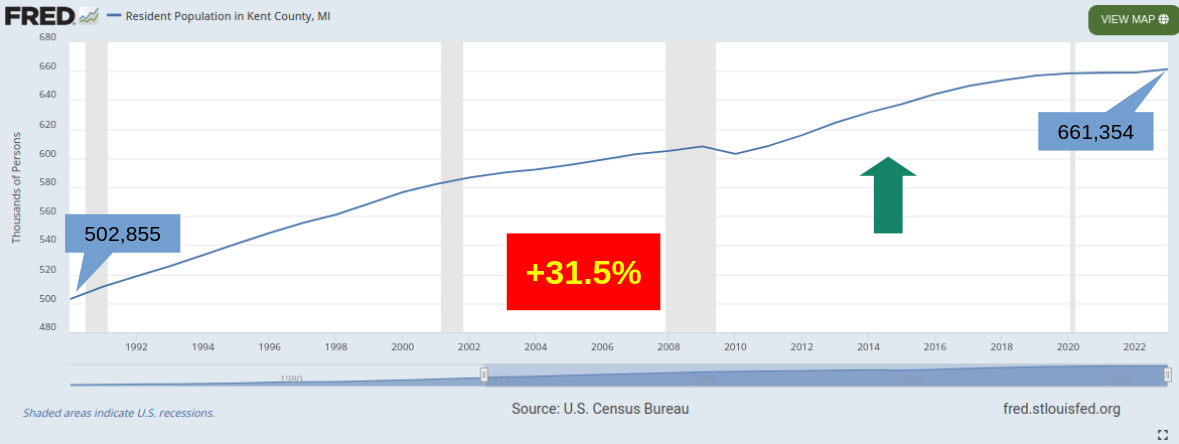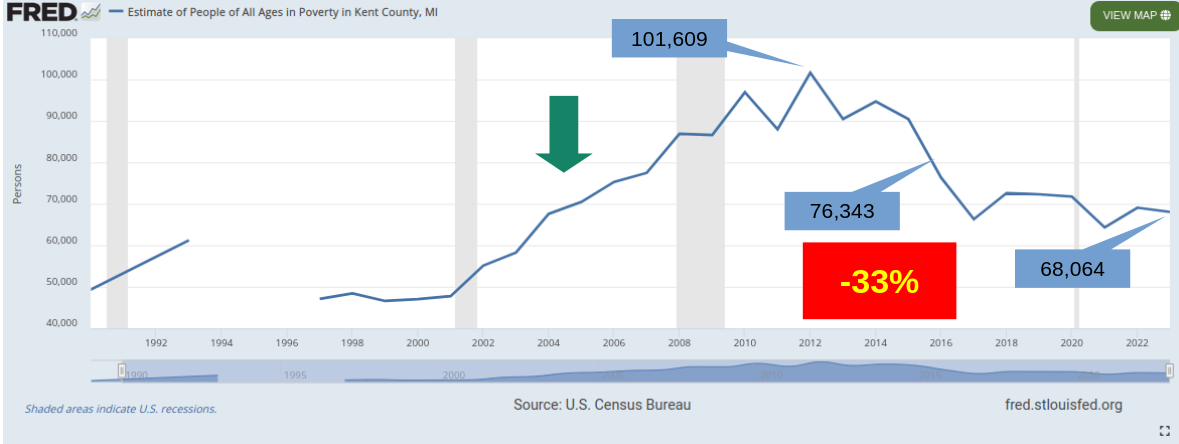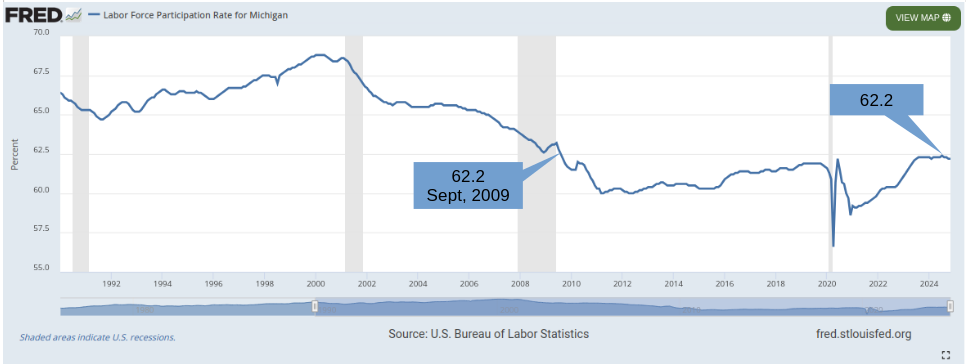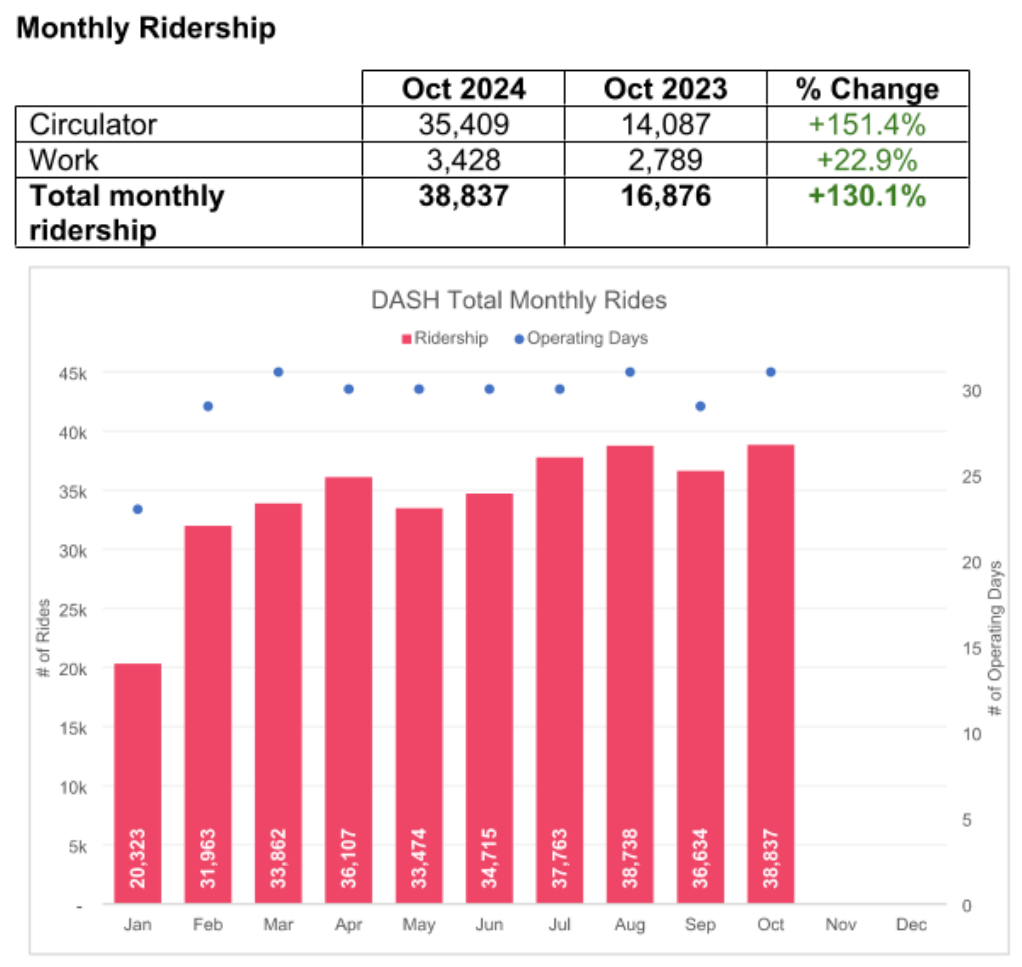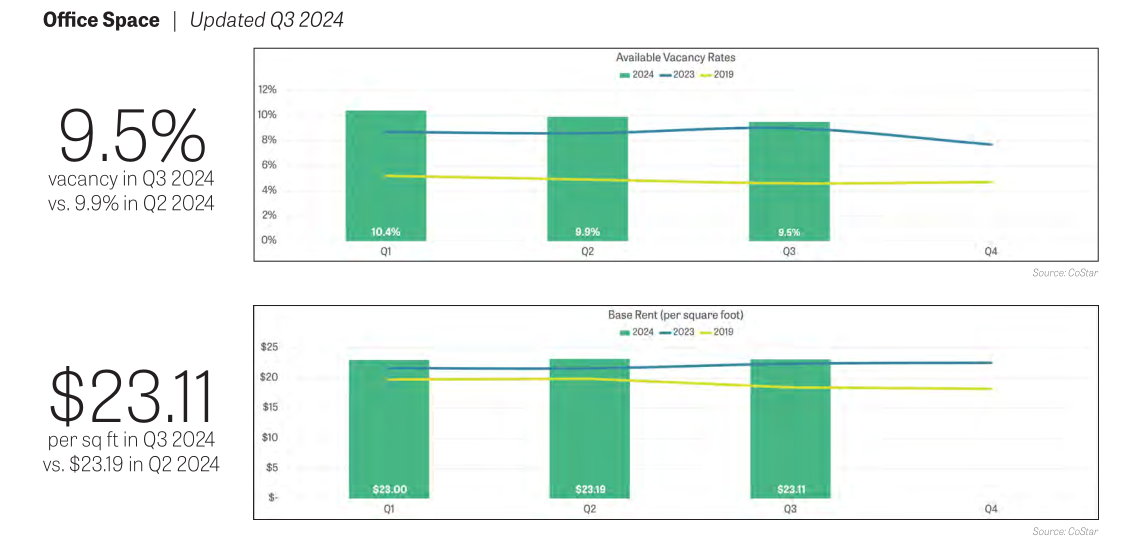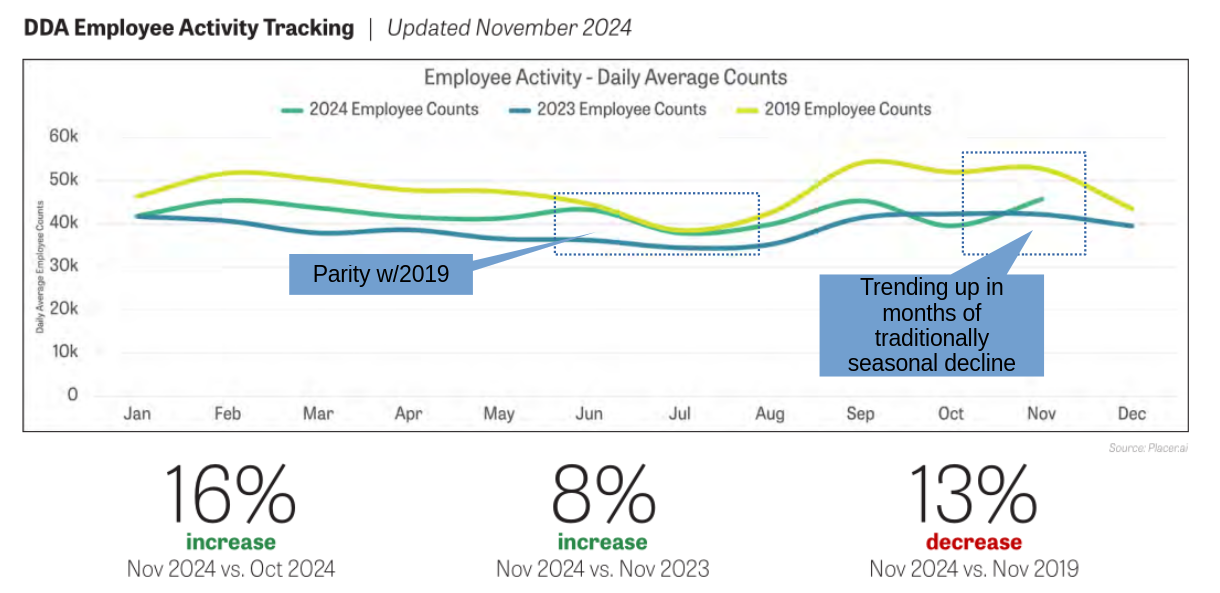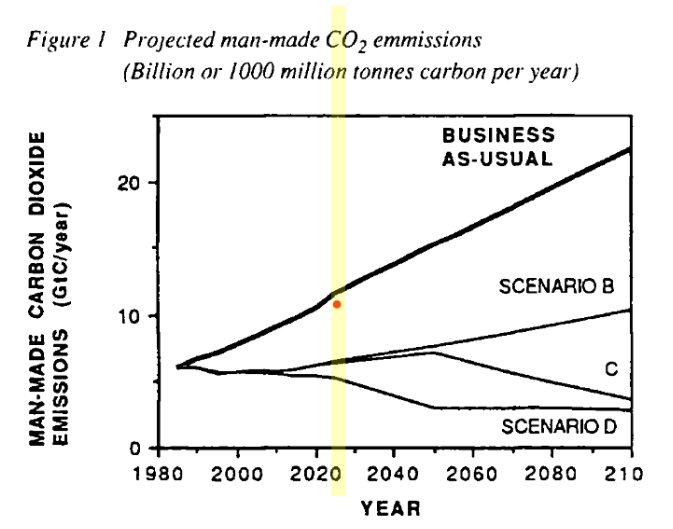Pondering 2025
The year 2024 has concluded, so now is the season for reflection and prognostication. How do you feel about the prospects of 2025? This image captures my current feelings about my city going into 2025:

However well managed and prosperous anywhere in Michigan, in the United States, has been, the tidal wave of delayed, deferred, or simply ignored challenges is moving. The question that holds my thoughts regarding 2025 is when does the wave reach us. Perhaps we will be spared for another year, or perhaps it will burst over the flood-walls in autumn after a long quiet summer, or it may crash down on us before we've even remembered to write/type "2025" instead of "2024". This sense of impending doom is brightly discordant with the forward motion of the city.
Wind In the Sails
The forward momentum of the city and the region is strong and long established; 2024 crowned that history with further accomplishments and promising news.
🟢 The City Commission finally adopted a new Master Plan: "Bridge To Our Future". The public engagement in the drafting of the plan was an enormous accomplishment in that it was a representative cross-section of the city's residents on multiplex axes of age, education, gender, and race. That is a stark contrast with how most Urban Planning documents come to be policy. The new plan acknowledges the urgent need for new housing as well as the pervasive support to solve this problem; clear support which overwhelms the relentless voices of negativity which mount against every change.
Accessory Dwelling Units | Duplexes | Triplexes and Quadplexes |
Hopefully the City Commission will remember and respect the representational validity of the plan as they move through the process of drafting the new zoning ordinance.
🟢 Downtown, with the Three Towers, may see the largest private development in its history. Or second largest if you count the railroads as private investment. The Detroit and Milwaukee railroad arrived in 1858, and then the Grand Rapids & Indiana in 1867. Even counted, it has been some ~150 years since downtown last saw a multiple-hundreds-of-millions-of-dollars investment by anyone other than the MDOT. And investments by MDOT, with scandalously few exceptions, only make the city and its citizens poorer.
The most important contribution the Three Towers will bring to Grand Rapid's is a large step towards Downtown's goal of 10,000 residents [as defined by the 2015 GR Forward Plan]. Downtown residential growth is critical to maintaining the city's cultural and economic trajectory. And downtown's residential trajectory? According to the DDA's metrics the level of residential activity has increased 39% over the pre-lockdown levels of 2019.
🟢 "venue" is the word of the year for 2024. The amphitheater broke ground, the soccer stadium project appears to be on rails, and the most ambitious project - the aquarium - has remained in the zeitgeist. In addition to the two mega venues downtown also gained putt-putt golf (Big Mini Putt Club, 70 Ionia Ave SW) and an indoor driving range (Gimme’s Par and Grill, 45 Ottawa Ave NW). Meanwhile construction is apace on the SILVA (975 Ottawa Ave) in Monroe North; the SILVA is the renovation of the old 50,000sq/ft Riverfront Fitness building into an entertainment venue with a capacity of 1,200 - 1,5000 customers.
It is often said that what a city is is a collection of neighborhoods, that the city is only as strong as its neighborhoods. I would add that Downtown is the neighborhood of the neighborhoods. While there is ample room for critique of particulars the strength of Downtown radiates out into the neighborhoods producing value and opportunity.
🟢 The retail scene has continued to develop. Walkable neighborhods require places to walk to. And in 2024 a long list of new store-front businesses opened their doors.
An incomplete list:
- Cellar Bird Books , 415 Bridge St NW
- Greyson Clothiers, 40 Monroe Center St NW
- Shinola, 40 Monroe Center Street NW
- Grammotones, 120 Division Ave S
- GVSU Laker Store, 101 Monroe Center St NW
- Artrat Gallery, 46 Division Ave S
- Alive Again, 1541 Plainfield Ave NE
- Orchard House Books, 1042 Michigan St NE
- Tone Chasers Music, 121 Division Ave S
- Feral, 1031 Wealthy St. SE
- Good Good Good, 1590 Plainfield Ave NE
- Boomtown Records, 1809 Plainfield Ave NE
- Ritual Wines, 972 Cherry St SE
- Water Street Art Gallery, 300 Ionia Ave SW
Thrift and vintage retail have been a trending sector through 2024 with something akin to a vintage district developing along Division Ave,
The beginnings of niche retail shops such as Alive Again (Horror) as well as multiple book shops is only possible thanks to increasing residential density of households with disposable income. Again, places to walk to. With a new Master Plan, and soon a [hopefully] much reformed zoning ordinance, we can continue to develop the retail granularity which provides both neighborhood vitality and economic opportunity.
🟢 Stepping out a bit to look at the region (Kent county) the story has also been one of steady successes despite the constant headwinds. I graduated high-school in 1991. A time that seems like a different age. Adjusted for inflation the per capita wealth of Kent county has increased by 57% (1990 - 2023). As someone who has been here all my life this change can be felt, it is visible. I have written before about the pervasive pessimism I experienced in my youth regarding Grand Rapids; Grand Rapids was a place people left, not a place in which [smart] people invested. That has changed.
A per-capita increase of 57% amid a steadily rising population. In the same period population increased 31.5%.
🟢 The region has seen the number of people living in poverty fall dramatically from its peak in the early 2010s, and continue to ever so slowy trend downward. Currently ~10% of Kent county households live in a state of severe economic distress, which by American standards, is a success [Michigan is ~13.5%, the United States is ~12.5%].
🟢 The gloom cast by the COVID pandemic has passed; this is another palpable change. The predictions of an "urban doom loop" or "urban exodus" and the devastation of local businesses did not come to pass. Today the labor force participation is equal to September of 2009; fifteen years ago. There are pundits who will relentlessly cling to the pandemic as an explanation for this, that, and everything which happens for years to come. Yet, in the data, the shadow of the pandemic and related shutdowns has receded to the horizon.
🟢 In the same category of pandemic recovery we return to the municipal level and the topic of crime. The crime anomaly of the pandemic era has also passed. Homicide rates have returned to historic lows and the Kia/Hyundai auto-theft spree is also over. This tracks with national trends of a sharp decline in crime. Nationally the homicide rate in 2023 saw the steepest decline ever recorded. Our fellow Michigan city of Detroit has seen the fewest number of homicides since 1967 (57 years ago). Why our leaders are not trumpeting these facts is difficult to understand, but I suppose I will get to that later on.
Homicides
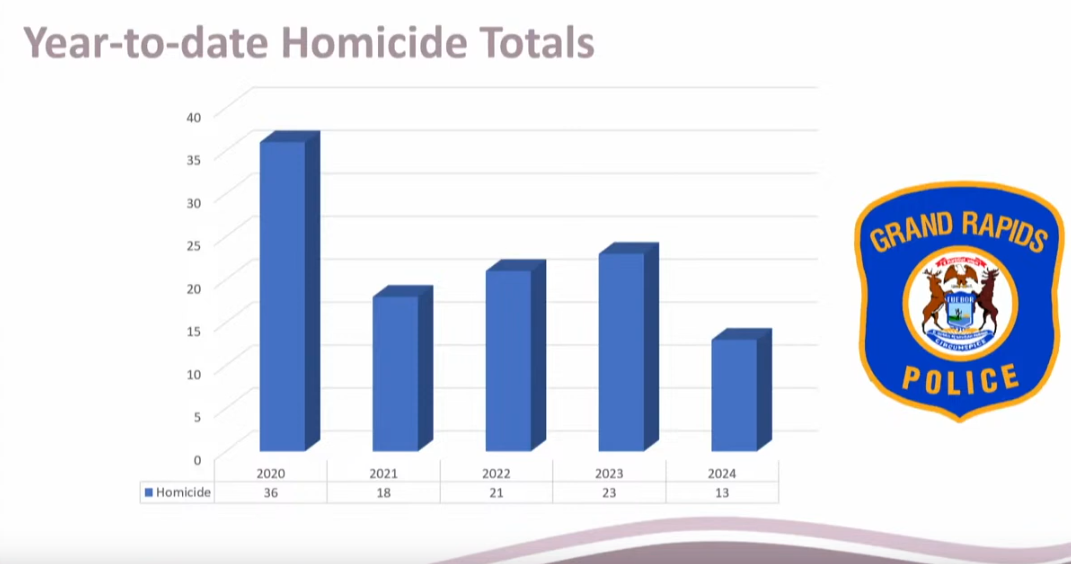
|
Clearance Rates
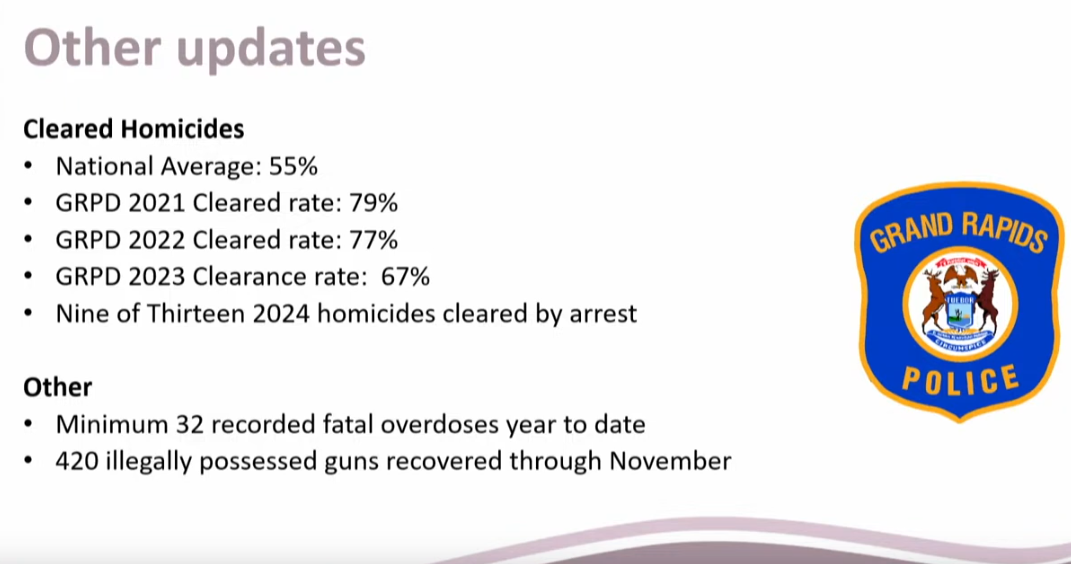
|
Auto Thefts
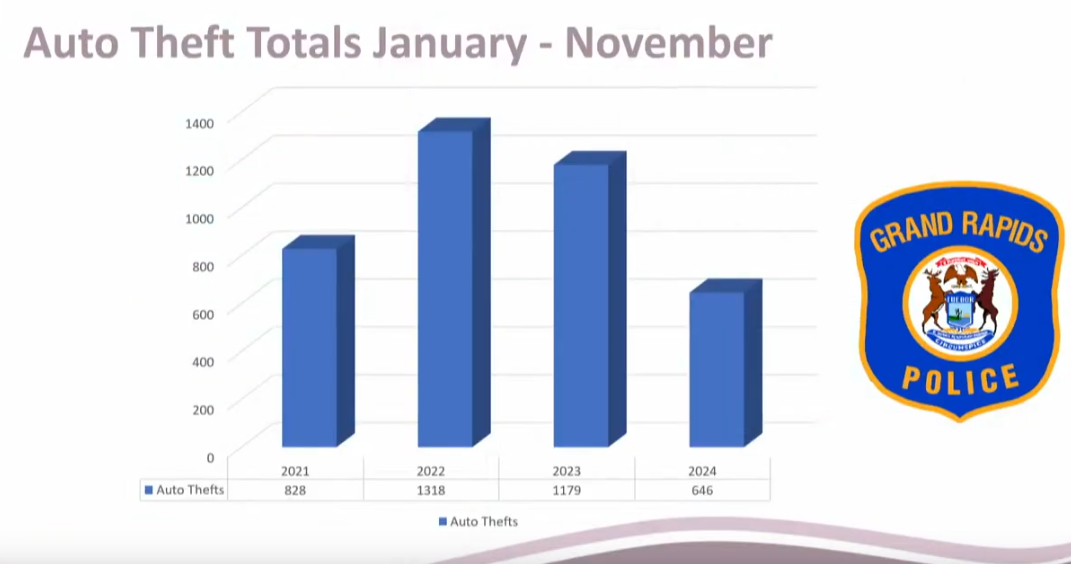
|
🟢 Another consequence of the pandemic and the shutdowns was on public transportation ridership. It cratered, for obvious reasons. False information about the danger of contagion on public transportation also drove people away. Since the end of the shutdowns the Rapid's ridership has been recovering at a steady pace. Due to funding constraints beyond the control of the agency service has also been reduced. The Rapid operated ~15% less service in 2024 than was provided in 2019. This reduced level of service may account for as much as 37% of the remaining ridership gap between 2019 and 2024. If the Rapid can match 2019 ridership is as much a question about funding as it is about demand.
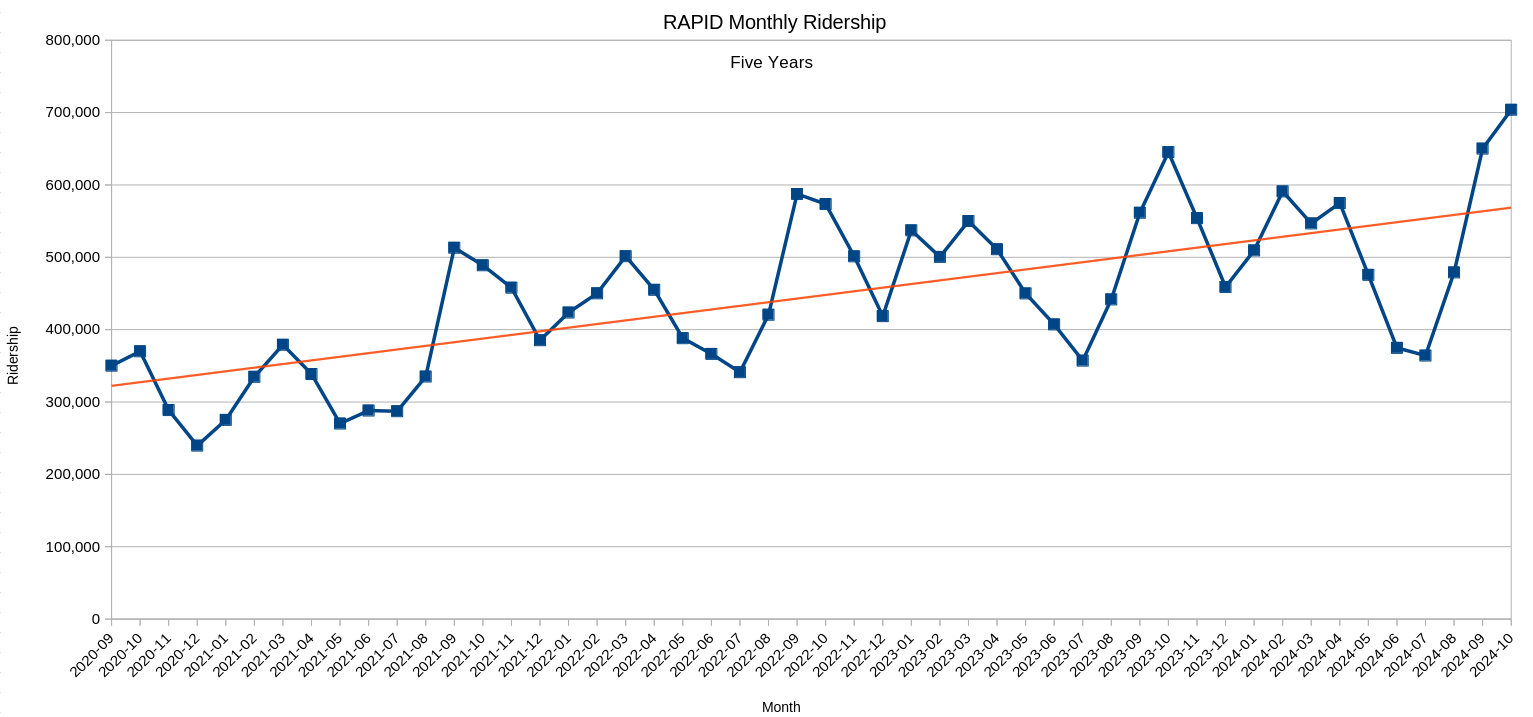
Elsewhere in the nation the New York subway and Seattle's light-rail system both broke their ridership records; the New York subway carried over one billion passengers in their fiscal year which ended in 2024. We also have a public transportation success story of our own: the DASH v3.0. The merger of the two DASH routes (North and West) into DASH v3.0 occurred in May of 2023, but the full schedule of service was not possible until early 2024, followed by a summer of constant detours due to road construction. Now the service has found its legs and ridership is surging; October 2024 ridership increased 130% compared to October 2023. The DASH is estimated to have closed out the year with over 392,906 riders.
The busiest DASH stop is the one located at Rapid Central Station, indicating the service is being used alongside other transportation services.
🟢 My last positive indicator, and possibly the most actual of the pandemic follow-on effects, is that of office space. Another of the "urban doom loop" tropes, this one has a bit of meat on its bones. In some cities the central business districts are staring down stunning office vacancy rates and tumbling commercial rents. While wildly exaggerated stories are abundant, the challenge facing office-park downtowns is real. Austin, TX has been reported by credible sources as having an office vacancy rate of 27.7%..
Fortunately, those levels of office vacancy are not happening here. The office vacancy rate in downtown Grand Rapids is ~9.5%, trending very slightly down, not up.
While employee activity downtown remains below 2019 levels, month to month, there are periods in 2024 when it reached parity with 2019, and the general trend is an increase.
In further contrast with the "urban doom loop" narrative a variety of businesses have chosen to relocate to downtown Grand Rapids, expand their downtown offices, or open satellite offices in downtown. These new office users will add to already recovering level of employment related activity downtown.
An incomplete list of companies moving to or expanding in downtown:
- Symplicity Communications Inc : expansion
- Independent Bank : new office (15,136sq/ft)
- GRLA
- Tesa SE : headquarters relocation
- Booking.com : relocation
- Ludus LLC : headquarters relocation
- Twisthink LLC : headquarters relocation (10,900sq/ft)
- PhotoniCare: headquarters relocation
- Lakewood Construction Co. : satellite office (2,200sq/ft)
- BDO USA : headquarters relocation (35,265sq/ft)
That downtown has fared so well in comparison to many others is largely due to the steady management of the Downtown Development Authority under the guidance of the GR Forward plan. Grand Rapids does not have an office-park downtown. The focus for years has been to diversify, to expand - most importantly residential - but also retail and entertainment. It worked! People, and corporations, will choose to remain in places which provide value, and places which continue to invest in themselves.
The Oncoming Wave
🔴 I'll begin this section with the chart I noticed in January of 2024. It is old, which is what makes it so chilling. It has been a year, and I cannot stop thinking about this chart. The chart is from a United Nations climate change report published in 1990. I had not yet graduated high-school. I am fifty two (52) years old. This report is thirty four (34) years old. Imagine making a dead-on prediction for thirty four years into the future?
The only change to this image I have made is to place the dot where we were, in terms of atmospheric CO2 levels, at the end of 2023; also the vertical highlight for visibility. That dot is a skosh beneath the "business as usual line". Thirty four years later. After all the climate agreements, climate conferences, climate this, and climate that. That dot, right there, a skosh below the line.
Please, take a moment to consider the enormity of that dot, on this old chart. . . .
Climate change is a looming threat, yes. Yet what this illustrates to me is a terrifying question: can we answer systemic problems? It is a question much larger than climate change. We have done a lot, or at the least we have performed a lot, and we have accomplished very little. We, as a society, have spent vast amounts of money - I was not able to find a total - to address climate change. And, there, right below the line, is that little dot. There is a great deal I want to say on this issue, and to climate change advocates. I have written that screed many times, and as before I have wisely deleted it yet again. I will allow that dot to have the floor.
🔴 Aside from some almost anomalous increases the population of the state of Michigan is not growing. It is also aging. As with climate change we have been talking about this for a long time.
In June of 2011 MLive published an article entitled "Census 2010: Surge of Baby Boomers reaching retirement is financial 'time bomb' for Michigan"
In May of 2014 the [now defunct] BLOG "Transportation for Michigan" published an article with the following text:
In Michigan, about one in six working-age residents will hit 65 in the next six years, and that rate will continue to increase until 2020. These stats are mirrored at the national level as baby-boomers come of age.
We have passed the year 2020. There has been some performance about addressing both the aging population and the stagnant population levels. Recently, we had Whitmer's "MI New Economy" (2021). Then she established the "Growing Michigan Together Council". In 2023 we were given the The Prosperous Future Report. There have been several of these working groups producing reports over the last decade. There has been no concomitant shift in public policy.
Today Michigan has seven (7) counties with a median age greater than fifty two (52) years old. What kind of economy can such a county have?
- Alcona : 59.3 years old
- Ontonagon :59.2 years old
- Keweenaw : 57.2 years old
- Roscommon : 57 years old
- Montmorency : 56.2 years old
- Presque Isle : 56.1 years old
- Iosco : 53.1 years old
This mirrors a national trend line. However - on this score - I would prefer to live in the outlier region than on the cutting edge. And it will get worse. The Economic Innovation Group recently published a list of seven states which have counties where government transfers [Social Security, etc...] account for a majority of household income. Michigan is not on that list . . . yet. That list is not a good place to be when the federal government is in an austerity mood.
Grand Rapids is a city in Michigan. We cannot fully escape the economic and demographic tides of our region, or the feckless mismanagement of the state by both political parties. The more Grand Rapids stands out as an economic bright spot in a failing state the more parasitic the state government will become.
Can we turn the ship, can we turn the recommendations of those reports into public policy? The juvenile tantrum which was the conclusion to the first Democratic trifecta in forty (40) years would indicate the answer is "no".
🔴 Michigan, with its incidental population growth and aging regions, has been steaming towards a "fiscal cliff" for decades. And we have not altered course. Even with the burden of its population issues much of this financial peril is self-inflicted. In 2011 the Snyder regime cut business taxes. Then in 2023 Governor Whitmer cut Michigan's income tax. Meanwhile Michigan has been steadily building out unsustainable infrastructure to support ever more sprawl which in turn supports ever fewer citizens per infrastructure dollar. For decades the state has compensated by keeping a greater share of the taxes it collects for itself.
Until the 2000s the state of Michigan honored a system of "revenue sharing" where it would return to the local governments a portion of the taxes it collected from the communities they made possible. Incrementally, every regime, Republican and Democrat, has shaved off more of that revenue to cover up the state government's poor investments and management.
State Revenue Sharing Over Time
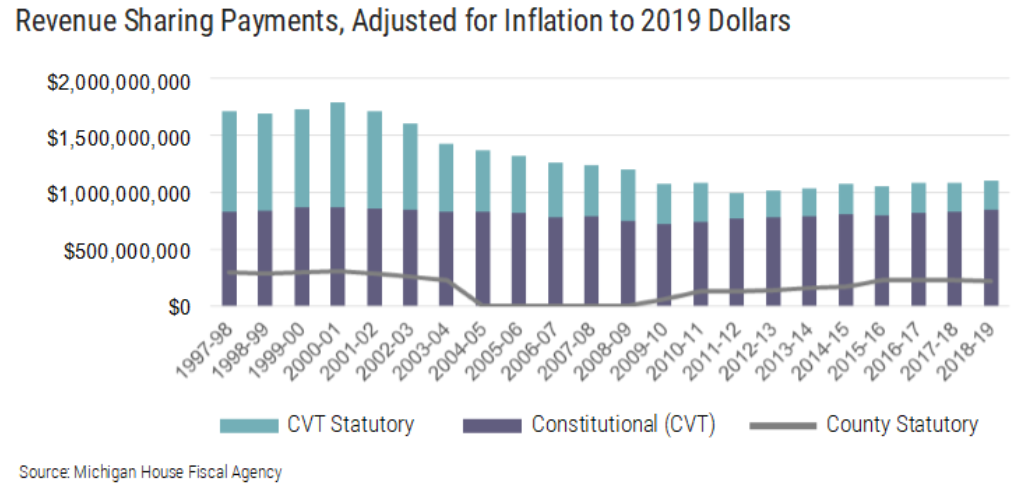
|
At the same time the state legislature has chosen not to relax any of the restrictions on how municipalities can raise their own revenue.
There was some hope this legislative year for reform of the state's current "economic development" policies [aka: SOAR] - which are essentially corporate hand-outs - to focus more on investment in our communities. Investments which would make those communities more attractive and competitive. Those reforms never made it to a vote. Governor Whitmer's focus was keeping her slush fund [SOAR] and, of course, road funding.
Is an adult conversation about revenue, infrastructure costs, and the effectiveness of "economic development" possible? It is a challenge to imagine it.
🔴 The housing crisis is yet another "crisis" which has been the on the floor for more than a decade. With as little progress made as with every other crisis. Housing sits at the center of everyhing; I am progressively ever more convinced of the truth of the "Housing Theory of Everything". Solutions for climate change, inequality, family formation rates, social discontent [lonliness], educational attainment, workforce participation, financial sustainability both household and municipal, ... all possible paths intersect with housing. Several of those challanges may be, principally, issues of housing. We cannot substantively address any of those crisis without dealing with the housing crisis.
On a human level how is the prolonging of the housing crisis not a direct governmental contribution to human misery?
As with every other crisis there has been no shortage of work groups and reports. In Grand Rapids our work grouping goes back at least to "Great Housing Strategies" (2015). Those initial strategies came forward in a period of historically low interest rates and humming supply chains. Yet, that window of opportunity was squandered for reasons. There were other more pressing concerns - such as how close a cannabis dispensary could be to a public park - which merited nearly an entire year of all consuming debate (2018). Housing would have to wait. From 2016 - 2020 the statements were always that, yes, the city was going to get serious about housing policy any-day-now-real-soon-just-a-bit-longer. Then the pandemic arrived. And the housing crisis would have to wait. Again.
The Housing NEXT update of 2023 documented a need for 7,951 additional rental units by 2027 and 6,155 for-sale units in the city by 2027. A total need for ~14,100 new homes, in five years. A need for ~2,820 new homes a year. How are we doing? Our average over the last ten years (2014 - 2024) has been 901 homes a year. Or 32% the required rate to meet demand. That is a staggering gap. Think about it as the city falling behind on its housing goals by ~5 homes every day. In the last week the city has fallen 35 homes further behind.
Housing Production
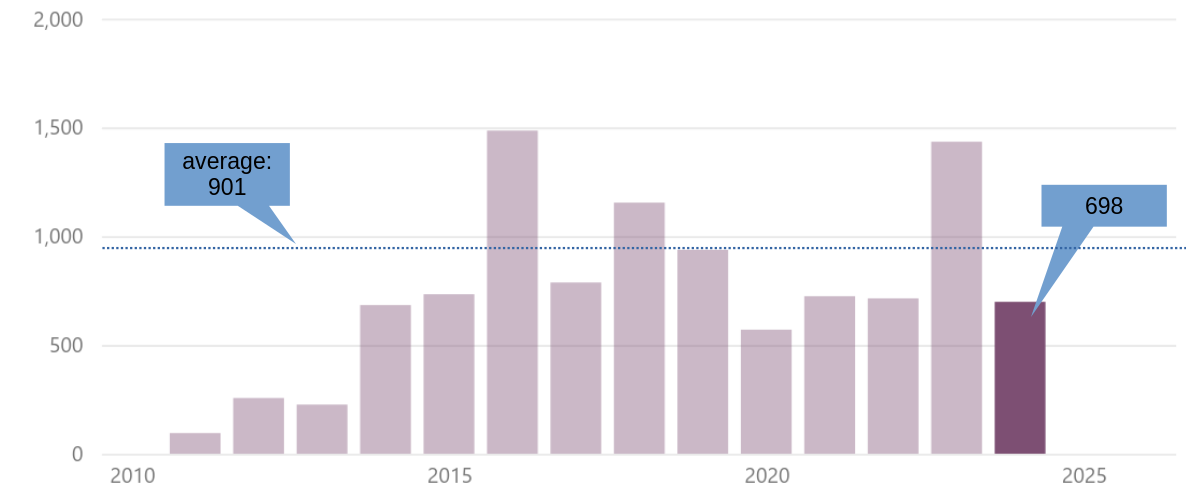
|
Now, here we are in 2025. A mere two years from the time horizon (2027) drawn by the city's Housing NEXT report.
Today we have a new federal regime which wants to dismantle HUD (Housing & Urban Development) and the loss of Michigan's Democratic trifecta [yes, for what little it was worth]. All those demands for more Affordable [income restricted] Housing? Those projects are built with LIHTC tax-credits backed by block grants and various HUD Community Benefit (CDBG) grants. In 2023 the US congress allocated $2.75/capita in LIHTC tax credits. What will that number be going forward? Will HUD even be a functional organization capable of distributing grants? Budgetted funds still requires a cooperating bureaucracy to make it out the door. Affordable Housing in the United States is constructed and operated upon a jenga tower of funding sources; remove a few pieces and it will come crashing down.
In Lansing we are certain to return to the bi-partisan performance of constant fiscal crisis [again, entirely of their own making].
Under the Democratic trifecta the house could not marshal the votes to allow duplexes state-wide. The following Democrats believe duplexes are somehow a danger to communities: Phil Skaggs, John Fitzgerald (Floor Leader), Veronica Paiz, Mike McFall, and Samantha Steckloff. [The position of Kelly Breen is unknown.]. Phill Skaggs, of East Grand Rapids, does not believe the housing crisis is a systemic problem. All of the bills related to housing died in the state house as the Democrat leadership could not assemble the quorum necessary to hold up-down votes. They did not even vote.
A city cannot grow, and it certainly cannot thrive, if this most essential component of a community - housing - is not abundant. The ever deepening housing crisis will continue to mount pressure against all other accomplishments. The failure to address this most basic human need will continue to erode confidence in our institutions.
Housing is squarely within the purview of municipal policy, this failure is here, it is in our own house.
In Conclusion
At the end of year-in-review essays like this the author is expected to provide a pithy summary or some note of hope. Upon surveying the last decade and the current political regimes hope is something I cannot find. The failures of our institutions feels overwhelming. When I wrote previously about the Optimism of the early 2010s I concluded with this quote:
Since then something went wrong. We, the people, chose the wrong people. Risks were not taken, risks were something to be avoided. We as a city have been expertly managed. That is true, and recognition of that is important. On the other hand we have not had leadership. Management and leadership are not the same. City Manager government - the system our city is burdened with by history - is intentionally anti-leadership. Yet, we need leadership regardless.
When hope is exhausted what is required is courage. However bleak the future may look our friends, our neighbors, and our community still need us, everyone, to keep trying.
To everyone who keeps trying: thank you.
P.S. Beyond all of these looming crisis are many personal ones. The new political regimes have promised particular challenges for some more than others. Those who do not look like me, or love as I do, or whose ancestors did not happen to cross some fictional boundary at an arbitrarily fortuitous time, the coming year(s) bring particular anxieties. These are our neighbors. These myriad smaller, but it no way insignificant, crises cannot be overlooked.

